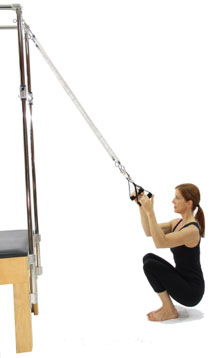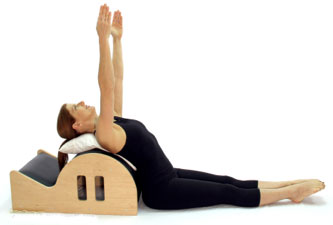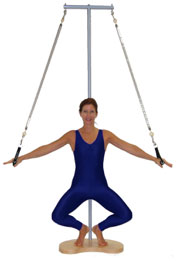Why You Should Use Pilates in Your Clinic

Joseph Pilates originally designed the Pilates apparatus to assist people with movement.2 The springs of the Trapeze Table, Reformer, Ped-O-Pul, and Wunda Chair are perfect for assisting people with strengthening.
Pilates generally starts in supine which decreases gravitational forces on the joints and allows adjustment of the amount of load the patient can tolerate. Then, the patient can progress to vertical with continued support from the springs, providing them with the opportunity to move the affected joints without pain!
By integrating Pilates apparatus into the clinic, you will integrate the concept of assisting patients with movements that are either painful or weak. Joseph Pilates designed the springs to to assist people with movement, making the apparatus perfect for a rehabilitation setting.
Pilates vs Traditional Strengthening
A recent randomized controlled trial compared Pilates to trunk strengthening and found favorable results.1 In the 101 subjects tested, Pilates was superior to a traditional trunk strengthening program in reducing disability and improving quality of life. These improvements were still seen 3 months after the study ended. There have been numerous studies looking at Pilates’ effect on low back pain and balance in older adults. These show that Pilates is either superior to or as good as a traditional exercise program.
Below is a quick look at a few of the Pilates apparatus and how they can help in your setting.
Reformer
If a patient cannot tolerate loading the low back, hip or knee in a vertical position, the person can lie supine on the Reformer to re-learn squatting or functional movements. The Reformer Footbar can also be modified to accommodate decreased knee or hip mobility and the springs can be adjusted to target the anterior or posterior musculature.

Trapeze Table
The Trapeze Table is excellent for giving support and guidance to the shoulder for re-education of shoulder movements in flexion and abduction, or for performing neural glides to either the upper or lower quarter. The flowing movements of Pilates as opposed to stretches held at end-range as in yoga or traditional PT are perfect for facilitating healthy neurodynamics! Also, the springs attached off the end of the Trapeze Table are perfect for assisting a patient with return to functional squats or lunges.
Ladder Barrel or Spine Corrector
The Spine Corrector truly is a spine corrector! The Ladder Barrel and Spine Corrector do an excellent job passively mobilizing the thoracic spine into extension especially targeting the kyphotic older adult. By placing the segment you want to mobilize at the apex of the barrel, you will target that area to move into more extension. The padded surface is often more comfortable and better tolerated than a foam roller as well.
Ped-o-Pul
The Ped-O-Pul is a simple and inexpensive tool that helps spinal alignment and unloading of the spine, hip or knee when the patient is ready to work in vertical postures! The Ped-O-Pul springs can be adjusted to assist the person with Squatting, Step-Ups, and Lunges to allow strengthening a joint that is normally painful in a vertically loaded position.
When the patient no longer needs the springs to assist with movement, the springs can be taken away or used to progressively increase load to the affected joints.
- Kofotolis, N., et al. (2016). "Effects of Pilates and trunk strengthening exercises on health-related quality of life in women with chronic low back pain." J Back Musculoskelet Rehabil 29(4): 649-659.
- Pilates, JH. (1945) Return to Life Through Contrology. Pilates Method Alliance: Miami, FL.













